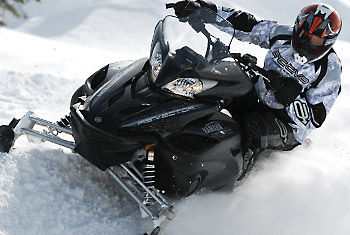There are so many conflicting opinions about which is best, 4-stroke or 2-stroke sleds, our minds just get boggled with the arguments.
Certainly, if you listen to Yamaha, who has been building an all-4-stroke line-up for a number of years now, you can be easily swayed toward that technology.
The other thing is, Yamahas have a tremendous track record of reliability and high resale, actually unmatched by anyone else. Don’t believe us? Check out prices of used RX-1s and Apexes. Unbelievable!
Okay, then talk to Ski-Doo about 2-strokes. This company has arguably advanced the development of good 2-strokes further than anyone else in the snowmobile biz and it’s impossible to argue with the gas mileage, cleanliness and performance of the company’s direct-injected E-TEC mills. These motors are light and deliver incredible value – all within EPA boundaries.
We’ve decided what it comes down to is the intended use consumers have for their particular snowmobile.
Deep snow riders are less happy with a 4-stroke sled because of its nose heavy weight. Long distance trail riders however, really love the smoothness, high torque output and quietness of 4-strokes. Performance focused riders love the agility and weightlessness of 2-strokes but have to admit a 4-stroke engine will likely outlive their 2-stroke – especially if it’s subjected to plenty of wide-open use.
One thing we’ve noticed is 4-stroke owners tend to keep their sleds a bit longer than 2-stroke owners. Maybe it’s because 2-stroke owners are convinced, based on past experience, after a couple of seasons it’s better to turn over the 2-stroke sled and get a new one before major engine repairs are required.
This has certainly been the case in the past, but with the new breed of 2-strokes out there now, we’re not sure this worry has much validity.



